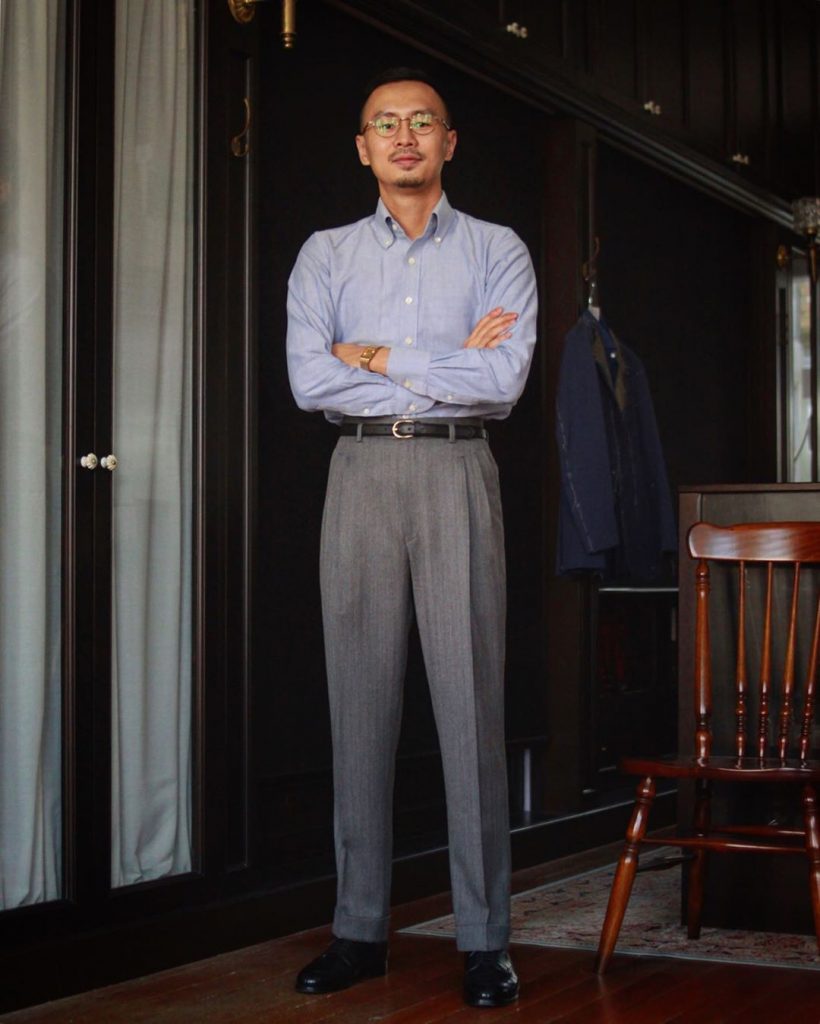
I found out about Dylan & Son last year through one of my tailors. While getting fitted in a pair of trousers, my tailor asked if I had seen Dylan & Son’s Instagram account. I had not, nor had ever heard of the shop. “The guy there makes excellent trousers,” my tailor told me. “They hang pin straight.”
Dylan & Son is run by a trouser cutter named Dylan Chong, one of the fresh new faces in the tailoring world. He started his company in 2010 after completing national service and graduating from Fashion Design at La Salle College of the Arts. Despite his relatively young age (he’s in his late 30s), he does excellent work. Some of the stuff I’ve seen from him online rivals the stuff coming out of Savile Row. Chong is passionate about classic men’s style, and he doesn’t use any block patterns (an industry term for pre-made templates, which are sometimes used to aid the pattern drafting process in bespoke). Instead, everything is drafted from scratch and by hand. For customers who want suits or sport coats, Chong also employs two full-time coat cutters, who work on-site. And his trousers do hang pin straight.
I also really like Chong’s use of social media. Recently, he posted some Instagram videos showing the fit and silhouette of tailored clothing. The best one, I think, is this 7-minute explanation of what he calls “The Golden Ratio” (the video is embedded below). People often use the term “fit” to describe all sorts of things that would be better termed as “silhouette.” In the strictest sense, the fit of a tailored jacket refers to a very circumscribed set of issues: does the collar hug your neck? Do the lapels buckle away from your chest? Do you see rippling down the sleeves? You can see our older posts for a rundown of how a suit jacket should fit.
Other things, such as the placement of the shoulder seams, are better termed as part of the silhouette. You can think of the silhouette as the general shape of a jacket. It’s what’s left when you remove all of the garment’s details (e.g., the pockets, texture, pattern, etc.). You’ve probably read the phrase “fit is king,” but the truth is, fit is just the starting point — what really makes an outfit is its silhouette. Silhouettes are a way to use clothes to give the illusion of a different body type, either slimming or augmenting our bodies, making them look more flattering or stylish in shape and proportion. And this is the most important dimension for whether something looks good on you.
When guys try on a new suit jacket or sport coat, they often check for fit in a very clinical way. They check to see if the shoulder seams are sitting on top of their shoulder joint. They pinch the back to see if the waist can be taken in. But more important than checking off these boxes is checking to see if the jacket actually looks good on you. In the video above, Chong goes through some instances when you’d want an extended shoulder line or looser waist. “Sometimes when you read fashion magazines, you’ll come across a quote that says something like, ‘a well-cut suit should follow the contours of the body,'” Chong says in the video. “I find that’s not entirely true most of the time. The suit should only follow the contours of the body if the contours are worth following.” (Perhaps a more delicate way of putting it: The goal is to flatter the shape of your body, not recreate it.)
I’ve embedded some of Chong’s videos below, along with a video The Armoury shot about the fit, silhouette, and proportions of trousers. Mark at The Armoury says they’ll be uploading a video about proper jacket length this week (I suspect it’ll be good, as their explanation on trousers is excellent).
When purchasing a suit or sport coat, train your eye for what looks good. Try on different models and get a sense of what looks best on your body. Shop at stores with sales associates who can help guide you through these issues. Be honest about how you look in something. We also have tons of guides on fit and silhouette, as well as full write-ups on how to understand silhouettes in tailoring and casualwear (there’s more room for non-traditional shapes in casualwear). Also, follow Dylan & Son and Mark Cho’s Instagram accounts, where you can see video explanations of these concepts.







